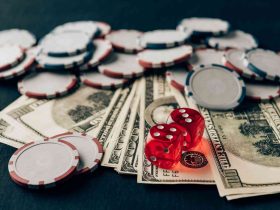Picture this: you’re seated at the poker table, your eyes scanning your opponents as you attempt to decode their strategies and hands. But merely excelling at this skill isn’t enough for sustained success in the game of poker. If your gameplay is rock-solid yet your bankroll remains stagnant, it’s time to examine the missing piece of the puzzle: bankroll management (or BRM for short).
It’s common knowledge that to step up to a higher stakes game, a player is often advised to have a cushion of around 20 to 50 buy-ins. Yet, the lure of higher limits can sometimes tempt players to take that leap with a far less substantial financial safety net.
We won’t dwell on the myriad reasons that propel players prematurely to higher stakes. Instead, let’s dive into the impact that such an early transition can have on a poker enthusiast.
In this piece, we’re going beyond the simple mantra: “Without BRM, you’re setting yourself up for a fall!”
Emotional Roller Coaster Rides
One of the most direct consequences of playing with aggressive bankroll management is the wild roller coaster of emotions that comes with it.
In just a span of an hour, a player might ride the high of being up by 2-3 buy-ins or feel the crushing low of the same amount lost. For a down-to-earth player armed with a 50 buy-in buffer, these swings are merely a mundane manifestation of variance. However, when a loss of 3 buy-ins significantly threatens your entire bankroll or forces a demoralizing drop to lower stakes, it’s a whole different ball game.
— Learn to play in the green — Personal development plan — Winning strategies for every stage of the tournament
This relentless chase for rapid advancement can lead to anxiety, an unhealthy fixation on bad beats, or even haphazard gameplay during winning streaks.
It’s a well-established fact that emotional turbulence can drastically deteriorate the quality of your in-game decisions, as the logical faculties of your brain get overpowered by emotions.
By subjecting yourself to frequent mood swings, you’re essentially shaving off a slice of your expected value, which in turn dents your win rate.
Suboptimal Play Under Bankroll Pressure
There’s a world of difference when it comes to decision-making with a mere ten buy-ins in your arsenal.
Even when you’ve accurately calculated your opponent’s range and know that going for the call is the optimal move after a hefty 50bb river bet, the fear of loss or aversion to risk might compel you to fold instead. It’s these moments where proper moves involve high risks and exposure to significant variance that can make or break the thin edge of mathematical expectation. If you find yourself shying away from an all-in with a mere 55% winning probability, you’re once again forfeiting expected value.
These small, yet critical, losses in EV can accumulate to a point where they prevent your win rate from tipping into the positive terrain.
The Pitfall of Inexperience and Lack of Distance at a Limit
The amount of experience a player gains is directly related to the volume of hands they have played. With only 10 buy-ins at their disposal, a player faces the heightened risk of depleting their bankroll quickly, thus eliminating the chance to accumulate substantial experience at a particular limit until they can either redeposit or grind their way up again from lower stakes.
Let’s suppose a player breezes through NL5 and NL10 in a month, only to face substantial losses at NL25, necessitating a reluctant step back down to NL5. This scenario isn’t hard to imagine if, for instance, the player’s BRM at NL25 was a scant 15 buy-ins.
Despite the fact that the player has risen from NL5 and conquered NL10 before, the second time around could play out differently. They might have cruised through previously while on an upswing, but encountering challenges on those same limits that previously seemed a breeze could shake their confidence and prompt risky in-game experiments.
A lack of mileage can mean that a player fails to grasp the real nuances of the limit they’re playing, as their experience could be severely distorted by variance.
To delve deeper into the world of gaming and explore reviews, tips, and more, be sure to check out topfinlandcasinos.com for comprehensive insights.
Conquering the Plateau: Insights for Poker Newbies
Embarking on the poker journey, it’s not uncommon for beginners to hit a snag, finding themselves stuck at a certain level for what feels like an eternity. For some, it’s just a few months, for others, an entire year might pass. In these moments, players often feel lost, unable to pinpoint the root cause of their stagnation, yet frequently it boils down to neglecting a conservative bankroll management strategy.
The allure of quickly escalating through the micro stakes can trap players in a torturous cycle of climbs and falls, ultimately leaving them running in place. This experience can be both disheartening and frustrating, akin to a hamster on a wheel, tirelessly working yet making no real progress.
Adopting a disciplined approach to bankroll management demands perseverance and unwavering self-control, but it’s this very resolve that facilitates a successful ascent through poker’s ranks without jeopardizing one’s financial stability. Casting aside sound bankroll practices, on the other hand, can cultivate a detrimental habit that may continue to haunt players well beyond the micro stakes. It’s crucial to rectify any misguided approaches to your bankroll early in your poker endeavors to pave the way for future success.
For those striving to climb the ladder, we recommend moving to the next stakes only after securing at least 40 buy-ins of your current level. For instance, if you’re looking to conquer cash games with a $2 buy-in, it’s wise to start with a bankroll of $80 and only consider progressing to higher stakes after netting an $80 win. For a deeper dive into the world of strategic gambling, consider checking out this comprehensive review guide, tailored specifically for enthusiastic gamers like yourself.













Leave a Reply